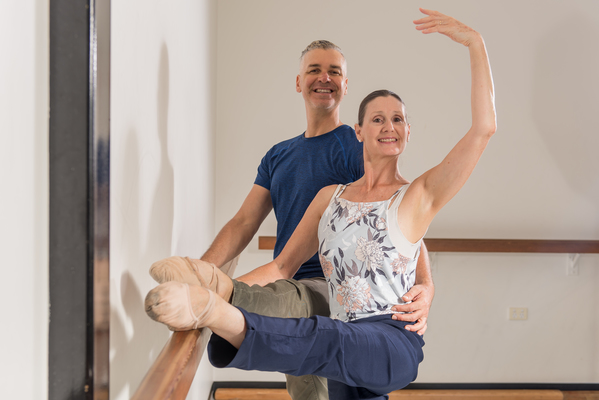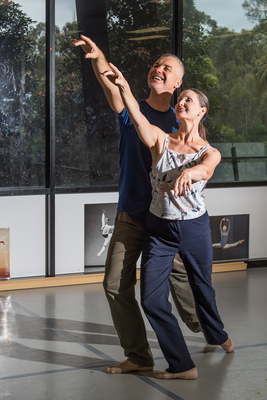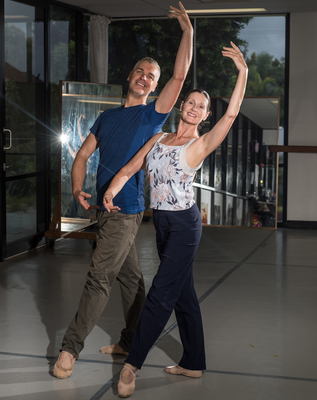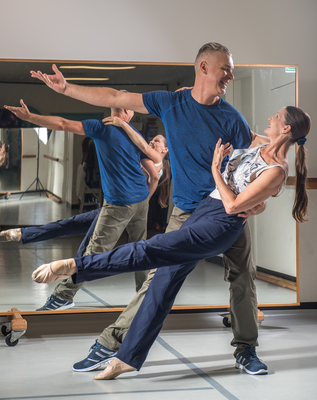By Margaret Maccoll
As her students were going through their routines for their Christmas concert last Sunday, Deborah Preece-Brocksom directed them with a quiet authority.
There was excitement in the air as Deborah advised on dance improvements and costume requirements, making sure the performance would be their best.
Deborah’s own career began when she saw Margot Fonteyn dance Sleeping Beauty on television as a four-year-old. It was something she knew she would do, and it remains the only job she ever wanted.
The Dance Centre Peregian Springs co-director with husband Richard Leader spoke to Noosa Today about a career that introduced her to her husband, took her to leading ballet companies across Europe and led to teaching, but began through illness.
“When I was nine, I had been seriously ill and the doctors told my parents to take me to ballet or Scottish dancing lessons to gain some strength,” she said.
“The local ballet school was luckily nearer by five minutes.”
Her natural talent shone out as well as her keenness for hard work and, as she admits, her obsessive compulsion to be “perfect”.
Within nine months, the recreational ballet school told her parents Deborah should audition for one of the UK’s full time ballet boarding schools.
She was accepted into the top four – The Royal Ballet School, Legat, Elmhurst and Bush Davies.
“My mother decided on Bush Davies as she said it had pretty dormitories and clean kitchens,” she said. “I loved it there and even when I was asked to go to the Royal Ballet Upper School at 16, I stayed on at Bush Davies.
At 17 Deborah gained a place in the Corps de Ballet in the State Theatre of Kassel in Germany after rejecting offers for the Royal Winnipeg Ballet and the Royal Ballet of Iran because her father decided they were too far from home.
Deborah said her mother was ecstatic when she joined the ballet and her father was very proud “once he got over his disappointment that I wouldn’t become an Opera singer”.
“My father insisted I learnt the piano in case, as he put it, I broke my legs” she said.
And the piano did become very important to Deborah as a way to relax after a long day in the studio.
The life of a professional ballet dancer is physically demanding as well as satisfying.
“Every day we started with a 90-minute daily company class at 10am which meant being in the studio at 9.15am at the latest to fully stretch out all my muscles and get rid of any aches and pains from performance the night before and to do strengthening work. After class was rehearsal until 2pm and then a break to rush home and eat and return to the theatre at 5pm to get ready for a pre performance short class, make-up etc and then the performance. On performance days, I got home around 11pm for a cup of tea, supper and bed. On non-performance days, the mornings were the same but we would rehearse from 5pm until around 9pm or later in the evenings.”
“My first really big ballet performance was in the Pas de Trois in Swan Lake, and it felt like I had finally reached my true home. I felt ‘completely fulfilled’.
Deborah and Richard met while they were both in the ballet company in the State Theatre of Braunschweig.
They ended up dancing Romeo and Juliet together, but in the beginning it took some adjustment to get used to each other.
“When we were first asked to dance as soloists together in a pas de deux from Corsaire, I was quite alarmed as Richard has wickedly amazing turns and a very smooth elastic type of jump, which I had to match,” she said.
“He tells me that my work ethic, arm movements and flexibility were intimidating. I think Richard did the most adjusting though so that our technique, style and most importantly arm and leg movements looked totally as one. He was one of the best partners I ever had, and I was never afraid on any of the really difficult or high lifts as he was so strong and dependable. I always knew he would catch me and that all my landings would be smooth and safe. He was a most considerate partner putting my needs above his.”
Deborah said with their life so consumed with dance she couldn’t imagine being married or living with a non-dancer.
“Professional dancers are really quite strange and complex and very obsessed with their art,” she said.
However, the couple didn’t pass on their dance obsession to daughter Celeste who rejected ballet at the age of 12 and turned her talents to design, fashion, film, theatre and now iridology.
“I think because she spent so much of her time with us in the theatre either in the dressing rooms, studios or stage she saw at a young age too much of the daily grind, the agony and pain, the relentless hard work and in those days the extremely meagre pay dancers endured,” Deborah said.
It was Celeste who persuaded her parents to move to Australia.
“I had 23 relatives in Australia,” Deborah said. “We sent out our daughter for a long holiday visiting them all over the country from Melbourne to a sheep station in the outback.
“After giving up our final jobs in professional theatre, for Richard as a dancer and choreographer and myself by then as a ballet director and choreographer, we realised that life in Europe was hard, cold and politically quite worrying. On her return to Europe, she asked us why on earth we were in Europe when we could be in Australia. We just had to come over and see for ourselves and of course after that first visit all we could think of was emigrating.”
Through teaching the couple believe they are passing on to recreational dance students “a passion and love of dance and the enjoyment of doing it well” and passing on “a precious heritage” to vocational students.
“Pure classical ballet cannot be taught through books or syllabi, but is passed on in the studio in class, from teacher to pupil. It is a duty to pass on this heritage if one has been blessed with having had some of the greatest teachers. Richard’s principle teacher at The Royal Ballet School was the world famous Richard Glasstone MBE and his contemporary teacher was Christopher Bruce a world famous dancer and choreographer.
“My first classical ballet teacher was Noreen Bush who had been taught by Enrico Cecchetti and danced in Anna Pavlova’s company and later Clara Gora who had been a student of Agrippina Vaganova and a Prima Ballerina in Russia and Hungary.”
The students they taught in Europe and Australia are now dancing in Hamburg, The Royal Ballet, English National Ballet, Scottish Ballet, The Australian Ballet and the New Zealand School of Dance. “Once they have had careers as dancers I hope they too will start teaching and will pass on our precious heritage to the next generation,” she said.











